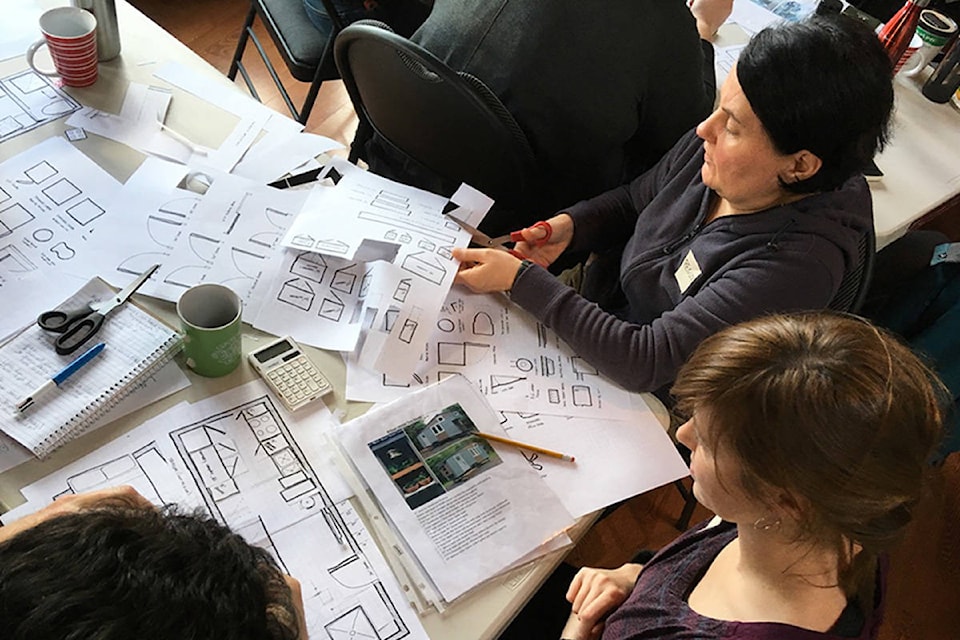It’s no secret that Victoria is facing a housing crisis. However, what is not so widely available, are alternative solutions to high-rise densification, but options are out there – and one is to live in a tiny home.
From June 15 to 17, Tiny House Courses BC, in partnership with KZ Permaculture and Tiny Healthy Homes, will hold a series of workshops led by Edmonton-based educator and speaker Kenton Zerbin, who lives and works out of a tiny home he designed with his wife, Melissa.
“It’s a trendy topic, but in Victoria in particular. The housing crisis means there’s such a crunch; people are really looking for solutions,” says Tobi Elliot, co-founder of Tiny House Courses BC.
In 2016, she began spreading the word about tiny homes – traditionally a structure anywhere from 18 to 48 feet long, and on wheels – by offering introductory classes on Gabriola Island, where she lives.
They quickly sold out, so Tiny House Courses BC decided to bring Zerbin back in January 2017, hosting workshops in Nanaimo and Victoria.
“The conversation was already happening and we sort of tapped into that,” Elliot says, adding the issue of affordable housing is no longer exclusive to Vancouver.
Want to take a #TinyHouse Course this summer? Watch this space! Mon June 4th, we’re running a weeklong contest to give away a FREE seat in EACH of our weekend courses w. @KentonZerbin! Stay tuned, details to come! https://t.co/bDZ4MyrJZk #tinyhome #build #yyj #yyjevents #Contest pic.twitter.com/4KKU3UCuFO
— Tiny House Courses B.C. (@tinyhousecourse) June 3, 2018
In Victoria, Tiny House Advocates of Vancouver Island, who formed in July 2017 with the goal of working with local governments to make tiny houses legal, has reached over 400 members and is growing.
Tiny homes have built a reputation as sustainable, affordable and community-building options for housing. But, there’s more to the concept than meets the eye, Elliot says.
“You can’t just look at a photo on Instagram or Pinterest and go – ‘that’s nice,’” she explains. “You have to know what your lifestyle is, what your energy needs are going to be, where you’re going to put it, how often you’re going to move it and how you’re going to work with the bylaws.”
RELATED: Local group wants tiny homes
The workshops discuss the principles of building, maximizing light and so forth. Participants choose from 15 designs, tweaking to preference, on paper. The blueprints are then transferred outside to a patch of land to see how that translates to a realistic setting.
“There are reasons why you design tiny houses in particular ways,” Elliot explains, pointing out they must be breathable, utilize proper building materials and stay within budget. Try not to build it with debt, she adds.
In Edmonton, where Zerbin parks his tiny house in a farmer’s field, the city amended five bylaws to make it legal.
In B.C. the desire is there to do the same, says Elliot, who considers the workshops a launchpad where interested tiny dwellers can access a large amount of research – the focus of which has now become how to work with municipal bylaws.
A rewrite of Tofino’s zoning bylaws is paving the way to allow tiny homes, while Central Saanich is currently conducting a study and holding open houses on how to zone and use land going forward, with structures like tiny homes and carriages houses in mind.
RELATED: Bylaw makes room for tiny homes in Tofino
“For interest to coalesce into a movement, you need dedicated individuals in a community who are going to build relationships with municipal officials together,” Elliot says. “Going forward to your municipality and having solutions already … that empowers them to come up with solutions for you.”
A pilot project for tiny homes is underway in Maple Ridge, based on a loophole found in an old bylaw left over from Expo ’86 designating RV’s as a legal unit in which to reside.
“It’s exciting news because it’s so transferable to other places,” says Ben Garratt, of Tiny Healthy Homes. “It’s a good starting point because it’s a big pain for municipalities to write new legislation.”
Garratt, who designs and builds tiny homes, says the project will open the door to legally allow such houses as a way of increasing density in urban areas. On Vancouver Island, he points out, “there is tons of land” where “you can easily park on five acres of land without bothering anyone.”
| Tiny house builder Ben Garratt says he fields calls from people in cities big and small, looking for affordable housing solutions, particularly in B.C. where the market has grown significantly in recent years. Photo courtesy of Tiny House Courses BC |
To create effective policies around land use that keep up with density, tiny houses are going to have to be part of that, he continues. “You can build high rises all day long but there’s still a lot of unused space in cities.”
Calls to Garratt come from people living in cities like Vancouver and Victoria, as well as those in smaller communities and more rural settings.
Things are changing in that regard, he says, as the fantasy of living off the land, and off the grid has morphed into living tiny, in a big city.
“[It’s the] most viable option for a lot of people; as soon as there’s some legalities ironed out, I can see it kind of exploding,” says Garratt, recognizing living tiny is not for everyone, but a great option in a housing market like B.C.
Elliot maintains creative housing solutions are imperative, especially for islands.
“The whole point is you don’t live for your house,” she says. “You live for your life and your lifestyle and part of that is community.”
For more information on the cost of the workshops, or to register, visit TinyHouseCoursesBC.com. Follow them on Twitter to win free tickets to workshops in Victoria or Shawnigan Lake.



